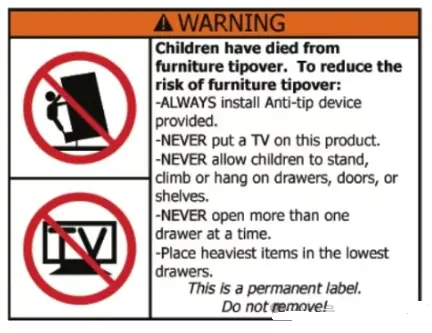
What is the Amazon ASTM F2057 Test Report?
Clothing storage products refer to furniture items with drawers or hinged doors used for storing clothes. Clothing storage units, such as wardrobes, cabinets, and drawers, are essential household items in everyday life. However, if these products do not meet safety standards, they can pose risks to consumers' health and safety. To ensure consumer safety, the CPSC (Consumer Product Safety Commission) has adopted ASTM F2057-2023 as a mandatory safety regULation for clothing storage units.
ASTM f2057-23 Standard Safety Specifications for Clothing Storage Units
This safety specification aims to REDuce injuries and fatalities among children caused by the tipping of clothing storage units. It covers wardrobes, drawer cabinets, chests of drawers, dressing tables, and closets. It provides detailed testing procedures for drawer stability. During the test, the unit should not tip over or be supported solely by open drawers, doors, or any open or closed lids.
1. Stability Requirements
The ASTM F2057 standard requires that clothing storage units must be stable when placed on the ground. They should not tip over or slide during use. Manufacturers need to incorporate stable support structures, such as four-legged supports or anchoring devices, to ensure stability during use.
2. Flammability Requirements
The standard also outlines flammability requirements for clothing storage units. The exterior surface of the unit must use flame-retardant materials to reduce fire risks. Additionally, the interior filling materials should also have flame-retardant properties to prevent the spread of fire. These requirements are designed to reduce the potential harm caused by fires to young children.
3. Small Parts Requirements
The ASTM F2057 standard specifies requirements for small parts in clothing storage units. During testing, clothing storage units should not contain any removable small parts that could be swallowed or inhaled by children, preventing potential injuries. If removable small parts are present, manufacturers must label the product with a warning to inform parents of the safety risk.
4. Other Safety Requirements
In addition to the above requirements, the ASTM F2057 standard includes other safety stipulations, such as:
- Sharp edges or tips of metal parts should not be exposed to prevent injuries.
- The surfaces of the storage units should be coated with non-toxic, non-corrosive paints to ensure safety.
- The units should have clear warning labels to alert parents to safety concerns.
In summary, the ASTM F2057 standard is an important safety regulation that outlines the necessary safety requirements for clothing storage units, including stability, flammability, small parts, and other factors. Manufacturers must ensure that their products meet these standards to reduce the risk of injury to young children from furniture tip-overs and related accidents. Parents should also choose clothing storage units that comply with the ASTM F2057 standard and follow usage instructions to ensure children's safety.
Test or Certification Information:
ASTM has released an updated version of the "Standard Safety Specification for Clothing Storage Units" known as ASTM F2057-23. The updated standard includes additional label requirements. The new warning label features an image of a child climbing a clothing storage unit, encircled by a diagonal line to signal danger. This warning label must be permanent.

The visual warning label emphasizes the potential risk of children climbing storage units. The CPSC has conducted a public awareness campaign to educate consumers about the dangers of this behavior. The label aims to visually alert consumers to the danger of such actions.
Additionally, the warning label must be "permanent." For paper labels, if the label cannot be removed without tools or solvents, or if attempting to remove it will tear or damage the label or surface, it can be considered permanent. For non-paper labels, the same conditions apply. "Directly applied to the product's surface" warning labels must undergo ASTM D3359, a test for adhesive strength using a tape adhesion method, to verify their durability.
In addition to label requirements, the introduction of ASTM F2057 clarifies that the standard does not address hazards caused by improper use of the product, including misuse that was not reasonably foreseeable by the manufacturer.
The most critical requirement in ASTM F2057, the stability evaluation, has not been amended. Although the CPSC has pressured for stronger stability measures or a lower height limit (30 inches), no further revisions have been made. The mandatory requirement to use anti-tip devices, as outlined in ASTM F3096 for clothing storage units, remains unchanged.
Originally developed in 2000 as a voluntary standard, ASTM F2057 aimed to reduce fatalities caused by tip-overs of independent clothing storage units 30 inches or taller. The standard defines a clothing storage unit as a piece of furniture used in a bedroom to store clothing, specifically mentioning cabinets, wardrobes, and kitchen cabinets. Furniture not covered by the scope includes shelves (such as bookshelves or leisure furniture), office furniture, dining room furniture, jewelry cabinets, under-bed drawers, or built-in storage cabinets permanently attached to buildings.
Although the standard is not mandatory, the CPSC strongly recommends compliance. Recent high-profile furniture recalls have referenced this standard.
Relevant Regulations: CPSC
Related Products: Furniture
Lead Time: Regular service 5 business days, expedited service TBD
Sample Size: 1 finished product
Email:hello@jjrlab.com
Write your message here and send it to us
 What Are the Testing Items of California Propositi
What Are the Testing Items of California Propositi
 E-Cigarette EU TPD Testing
E-Cigarette EU TPD Testing
 Testing Certification for E-cigarettes Exported to
Testing Certification for E-cigarettes Exported to
 What is Amazon US CPC Certification?
What is Amazon US CPC Certification?
 UK Toy Safety Regulation Standard EN 71-13
UK Toy Safety Regulation Standard EN 71-13
 What is EU UFI Registration?
What is EU UFI Registration?
 EU UFI Registration for E-cigarette E-liquid
EU UFI Registration for E-cigarette E-liquid
 How to get the MSDS Report for Electronic Cigarett
How to get the MSDS Report for Electronic Cigarett
Leave us a message
24-hour online customer service at any time to respond, so that you worry!




